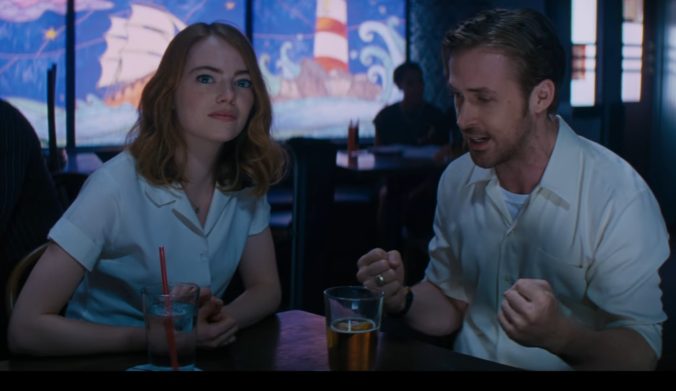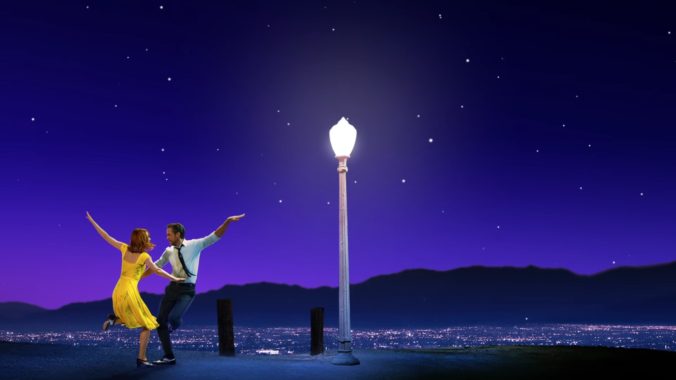I saw “La La Land” late on a Friday night. It was something like a 10:20 p.m. showing. The crowd was underwhelming. I easily got my favorite seat in the theater: front section, back row, dead middle. I took my routine trip to the bathroom after the second trailer and sat back down. Film rolled.
Two hours later, I floated out of the theater, the molecules that used to make up my body bouncing off the walls, some of them wandering up into the stars. I assume they were dancing up there. It was cold when I went outside. I didn’t feel it really. If the theater wasn’t closed, I probably would have turned around and walked right back inside to see “La La Land” again anyway. I think I would have easily paid twice the price.
I could have lived inside “La La Land” forever. I could have met a girl, raised a family, worked on my 401K or something, and died peacefully inside “La La Land.” I never wanted it to end.
Damien Chazelle views the world through a lens more beautiful than I can ever imagine. Justin Hurwitz hears the world through speakers far too expensive for me to purchase. Ryan Gosling and Emma Stone perform in ways the English language is not even properly equipped to describe. Their chemistry sparks in ways I highly doubt any language is equipped to describe. The production design, the set design, the costumes; everything is simply elegant. To call it aesthetically pleasing is insultingly inadequate when I consider how at home and comfortable and joyful the movie made me feel. The songs are in my bones now it seems.
I don’t like to gush like crazy about things because I think that makes it easy to not take people’s opinions seriously. So I’ll get off this train. The experience is passed. Instead of ranting and raving, let me just get some of my thoughts out here. There’s a lot of meat on the bones of “La La Land,” and I just wanted to throw out some of the ideas I’ve been thinking about since seeing it.
ooo
I don’t think anyone would tell you “La La Land” is a sequel to “Whiplash,” but in the, you know, “spiritual sense,” it kind of felt like it was. Damien Chazelle clearly loves jazz and loves movies more than I’ve loved anything in my entire life, and it comes across in every frame and musical note of this movie. (Note: Score by Justin Hurwitz.) And when it comes to “Whiplash,” I felt like “La La Land” explored areas of music and movies that “Whiplash” simply didn’t have the time or energy to explore.
In “Whiplash,” Miles Teller alarmingly dumps the charming and beautiful and fantastic and no-I’m-not-in-love-with-her-and-I-definitely-haven’t-seen-every-episode-of-“Supergirl”-why-are-you-asking Melissa Benoist for no other reason really than he’s a major dick. It’s brushed aside and the movie pretty much moves on. The music was always more important. In “La La Land,” it felt like Chazelle wanted to explore the flip side of that relationship: a world where the relationship is more important, one where putting art above it is a mistake.
It’s not that cut-and-dried of course, and I’m pretty sure for Chazelle art always wins out, but watching “La La Land” unfold, I felt like it more deeply explored what it truly meant to chase an artistic dream. Not just the blood and sweat and tears and J.K. Simmons-yelling-in-your-face-40-times-a-day of it all but the emotional toll it takes on your relationships with those you love.
Chazelle doesn’t speak through his character’s words as much as through their actions and Hurwitz’s music. He couldn’t have picked better vessels in Gosling and Stone, and his music and production squads are second to none.
The film builds to a moment where Emma Stone’s Mia is auditioning for one last movie. She’s at a point that is truly make-or-break. And in that moment, she lays her heart on the line. “Audition (Those Who Dream)” is a beautiful, beautiful, beautiful song that will knock you on your ass in the theater. It’s an ode to those really willing to fight and take risks in order to make it artistically, and Stone’s performance shows the toll that fight has taken on her character.
The interesting bit comes from the way the song (and movie) frames the idea of that fight. It constantly reminds us of its heavy cost, but it also romanticizes the journey in a contradictory and deeply human way.
This was best exemplified in the film’s final number (SPOILER ALERT) where Mia and her husband sit in on a performance by Gosling’s Sebastian at his jazz club in Los Angeles. Mia and Sebastian have both “made it” in their respective fields, but things don’t seem quite as romantic as they imagined. Because the price was their relationship. Everything that one is reaching for and everything that one has already reached seems much more romantic outside of those particular moments.
In fact, Sebastian’s piano transports Mia back to her year with Sebastian and tints it, alters it, re-imagines it in a slightly more positive way, one with a happier ending, one where everything works out and they’re still together. The music takes her on a beautiful, fantasized journey of everything that happened in the film previously. It’s not the same, of course. There are no downsides, no fights, no struggles. And in the end, Sebastian is the one who walks into the jazz club with her that night. But then the music stops, and Mia is right back where she started, wistfully imagining a much more romantic version of her life than the one she wound up with. What she doesn’t realize in that moment is that the reality of everything that happened before is just as beautiful as the way she imagined it. The reality was as breathtaking as her imagination. And just because she is looking back on it differently doesn’t mean those things aren’t true, or that those things didn’t happen. “La La Land,” in all its wonder and whimsy, reminds us of the breathtaking grandeur of everyday life and the awesome beauty of the struggle. I wonder if it’s bombastic ending will keep even us from recognizing that.
ooo
The characters in “La La Land” talk often about the past versus the future. This is quite fitting for a classical musical being made in 2016, particularly one that’s goal seems to be “bring back musicals in the movie theater.” Mia represents the future, a passionate artist thinly veiled as a cynic. Sebastian represents the past, a vestige of jazz music of yesteryear desperately trying to hold on to the way things were before.
In the movie’s final musical montage, “La La Land” unites the past and the future and shows how beautiful the result could be if we didn’t spend so much time debating which was more important and focused on the present itself. (In the same way, the characters in the film are constantly looking forward to something or backward toward something that has already passed.) During those final moments of the film, everything is united and beautiful and perfect. Then, the future and the past smile at each other and go their separate ways, leaving the rest of us in the present on our own.
I wish I could have held on to that feeling of beauty and perfection. But eventually I was back in my apartment, staring at my computer screen, just thinking about watching “La La Land” again.
I think I missed the point. What a waste of a lovely night.

